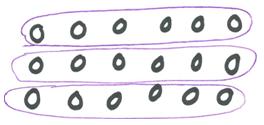The key idea of equations and expressions at level 2 is that number operations and strategies to solve number operations can be recorded using words, numbers, diagrams and symbols.
At level two students need to use words, numbers, diagrams and symbols to explain their mathematical thinking to others. These representations are thinking tools that help students understand what is happening in the problem, and keep track of their solution. At level two this includes the use of:
- Empty number lines to record addition and subtraction problems. For example the diagram below records both “25 + 25 = 50” and “50 - 25 = 25.”
- Arrays to record simple multiplication and division strategies. For example the diagram below illustrates both “6 x 3 = 18” and “18 ÷ 3 = 6.”
At this level students also need to begin developing an understanding of the equals sign as meaning “equal to” or “the same as.” Introducing students to equations such as 7 + 2 = 5 + 4 helps them to understand both sides of the equals sign represent the same quantity. This helps to correct the common misunderstanding among students that the equals sign indicates a number operation needs to be performed, as when using a calculator.
This key idea develops from the key idea of equations and expressions at level 1 that that counting, grouping and equal sharing strategies can be recorded using words, numbers and pictures.
This key idea is extended to the key idea of equations and expressions at level 3 that equations show relationships of equality between parts on either side of the equal sign.

